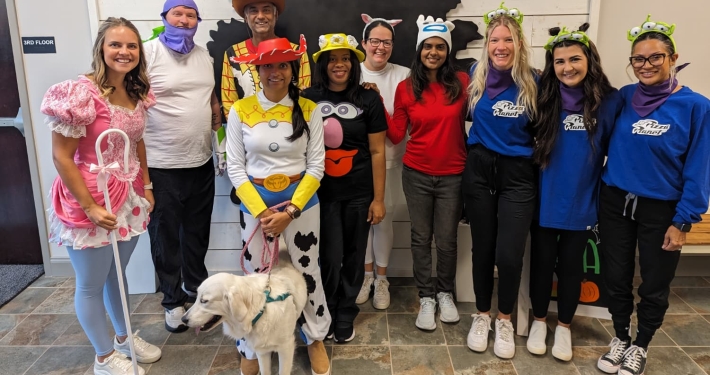Increasingly, families are looking to pediatricians for education on how to create healthy boundaries around digital media use. What do families and pediatricians need to know in order to support kids in practicing online safety? What is online safety, and what does it look like in practice? Marissa Maldonado, CEO of Proda Technology, speaks to these questions and shares her thoughts on starting generative conversations at home with children of any age, as both an IT professional and a parent.
The Perennial Questions of Screen Time and Children’s Health
The impact of digital media on children’s health is well-documented, and it seems that everyday new research reveals the risks of overuse. And yet, we are living in a time where it’s harder and harder to create and maintain boundaries around technology use for both adults and kids. Parents may use screens to wind down at night, and thus children see screen time as a tried-and-true method of self-regulation. Children’s understanding of tech outpaces their parents, so parents aren’t always sure how to talk to their kids about technology or set appropriate boundaries. More and more, online time is an essential element of children’s sense of belonging and connection, and their education as well. In this quickly evolving landscape, how can pediatricians support families in creating internet safety at home? How is internet safety defined, and what does it look like in practice in families’ homes?
Marissa Maldonado, CEO of Proda Technology, explains that simply creating rules and boundaries around technology use at home is not enough. First and foremost, when it comes to safe technology use, both children and adults need to learn how to practice self-awareness. Maldonado offers her expertise on internet safety from many varied perspectives. She’s the CEO of a Managed IT and Cyber Security Services Company that serves and educates many clients; she’s a small business owner; she’s a critical thinker and (in her words) “a lifelong IT nerd;” and she’s a mom to two young children.
“It brings me a lot of joy to educate people on something that can be really scary for them,” says Maldonado. “Being able to simplify cyber security and support people is really fun for me. It doesn’t feel like work.” Maldonado explains in digestible terms what the landscape of online safety looks like today, and how both parents and pediatricians can support kids in navigating it safely. In a climate of concern around rapid technology development and use, she offers a breath of fresh air on the positive impacts online connectivity and fluency will have on younger generations, while also acknowledging the very real risks. Most of all, she advocates that we all practice compassion for ourselves as we integrate this relatively new way of connecting to and working with one another.
Today’s Digital Media Ecosystem
Children’s safety online is, of course, front of mind for many families. Risks for kids online span the gamut from online bullying to stealth advertising to unwitting exposure to inappropriate content. In testimony before Congress on behalf of the AAP, Dr. Nusheen Ameenuddin, chair of the American Academy of Pediatrics Council on Communications and Media, gave this overview: “Health concerns [for children] from media use range from increased likelihood of obesity, poorer sleep quality, engagement in high-risk behaviors among older children and teens, and higher incidence of mental health concerns like depression.” Children’s safety online clearly needs to be prioritized, but technology evolution and use is progressing faster than our response to it, and our understanding of its effects.
According to the AAP, “today’s children are spending an average of seven hours a day on entertainment media, including televisions, computers, phones and other electronic devices.” This figure represents a rapid increase in digital media consumption over the last decade, almost doubling since the early 2010s. Further, most parents in the U.S. own smartphones and allow their young children (age zero to four) to use their devices. “Up to 75% of young children have their own tablets and most infants are estimated to start handling mobile devices during the first year of life,” the AAP reports.
While research finds that children less than a year old are routinely handling smartphones, the WHO recommends no screen time whatsoever for children under two and no more than one hour of screen time a day for children aged two to four. Screen time for young children hijacks attention span, decreases impulse control, and reduces empathy, according to an article from UNICEF. The author asserts, “face-to-face interactions are the only way young children learn to understand non-verbal cues and interpret them.” Underdeveloped empathy and social skills are potential risks of too much exposure to digital media early in life. With this kind of troubling information circulating, how do families manage the real risks of digital media use while also being realistic about their childrens’ needs, and their own time constraints as parents?
Marissa Maldonado is CEO of Proda Technology, a woman-owned family business out of Atlanta, GA. She’s also the mother of a one-year-old and three-year-old. Maldonado puts a finer point on the recommendations above, while also acknowledging that parents are human. “From the perspective of children’s psychologists, we should not be giving young kids technology to regulate their emotions. Period,” she emphasizes. “The research on the long term impact of what that does isn’t even out yet. We don’t yet understand what the phone-as-pacifier does to the emotional regulation of our children. The message we’re sending them is: you’re upset? Go into the screen and zone out; leave your experience. It’s terrifying.”
“But,” she continues, “we’re human. Parents get tired. I think we can use screens with our kids, we just need to be mindful about how and when we’re using them.”
“Adults use tech to regulate our emotions too. Screens are relaxing, they’re easy. I think it’s really important for us to be kind to ourselves as we’re navigating parenting with so many digital-babysitter options.“Marissa Maldonado
Boundaries and Balance: Practicing Technology Realism
With the majority of young children interacting with smartphones during early critical years of brain development, the proverbial train seems to have left the station when it comes to children and technology use. In her 2021 testimony before congress, Dr. Nusheen Ameenuddin asserts, “As pediatricians, we recognize the need for moderation in device use, and we have adjusted the ways we counsel our patients to reflect our new reality. We are not simply preaching device abstinence or demanding families make unrealistic sacrifices that do not align with the modern world.”
For children under two, the top-down advice is clear that families should do their best to limit all screen time. But for older children, rather than trying to take all tech away, parents and pediatricians’ time might be best spent supporting children in creating healthy relationships with technology. Maldonado speaks to this balance: “We’re parents, we’re surviving!” she says with a knowing laugh. “Sometimes you have to give them the phone.”
Maldonado suggests creating other practices with kids around emotional regulation before offering technology. “The rule that I continue enforcing is that, if you’re crying, I’m never gonna give you the phone,” she explains. “I’ll have my daughter do breathwork, or even set a timer and say, ‘You need to be calm for 5 minutes before you can use the iPad.’ Then let her play a game once she’s regulated on her own.” Maldonado emphasizes that each family needs to uncover what language works for them through iterative conversations with their children.
“Adults use tech to regulate our emotions too,” she says. “Screens are relaxing, they’re easy. I think it’s really important for us to be kind to ourselves as we’re navigating parenting with so many digital-babysitter options.” Maldonado continues, “We must be continuously kind to ourselves and each other to find a constructive way through toward moderation.”
The Silver Linings of Digital Media Use
While there is so much discussion of the risks of digital media use for kids, Maldonado believes it’s important to talk about why we want to use these technologies in the first place and how they can be supportive in our lives. “There’s so much common sense to the online world,” she begins. “Be aware, don’t be a bully, don’t let social media be a way to validate your self esteem.”
But beyond those essential precautions, Maldonado sees potential.
“Some people feel horrified when we talk about the future of kids and technology,” she says. “But if we’re doing everything we can as parents to imbue our kids with good values, humanity, being nice to each other, having integrity, if we’re teaching all these core values… our kids can come into this world and code those values into AI generation, to shape positive social movements through social media, and change the world for the better.”
The online world creates spaces for young people to come together, learn, and organize, regardless of geography. When used well, social media allows people to build cross-cultural empathy beyond what was accessible to older generations. “Being able to have that community hive mind where they can get information rapidly, and then knowing how to validate that information, is super powerful,” Maldonado says. “They can quickly learn what might not be right in the world and seek to course correct.” This phenomenon is exemplified by movements like Tarana Burke’s #MeToo, or the 2020 surge in BLM protests, both catalyzed in large part by Twitter, Instagram, and other platforms.
For teenagers, social media has allowed them to stay connected to their friends’ lives during times of distance, like the COVID-19 pandemic. These young people, adept in online community-building, will be able to deftly navigate an increasingly global, online work environment as they come of age. “The reality is, our world and our workforce is continuously and rapidly changing,” says Maldonado.”There’s a shift in our cultural demands of work life in terms of what young people need to feel fulfilled. Online connectivity will help them spend more time doing what they love outside of work and less time on stuff like commuting. It’s already doing this.”
Maldonado concludes, “I think we need to trust that our children are going to step up the game on what we’re doing with technology. And yes, we need to make sure we’re harnessing their energy for good.” So, how do families and pediatricians help children “harness their energy for good?” According to Maldonado, by teaching internet safety and healthy self-awareness from a young age.
What Is Online Safety?
“Online safety can be achieved through cybersecurity, to a degree, but cybersecurity needs to be accompanied by awareness and culture building,” Maldonado explains. Proda Technology is a cyber securities and IT vendor, and works with EHR companies like PCC. With new clients in the field of pediatrics, Maldonado finds analogies helpful in teaching the basics. “Sometimes with pediatricians I use the analogy of vaccines,” she says. “What do vaccines do? They protect us from viruses. Okay, now let me transition to cybersecurity. These tools protect us from viruses and other nasty diseases that mutate all the time in the online world.”
“There are many tools out there we can use in terms of cybersecurity,” she continues. Maldonado explains the basics: “You should know where your devices are at all times, and you should make sure you have protective tools installed on all of your devices. That’s like making sure you have locks on the doors of your house,” she says with a laugh. She references helpful tools like Net Nanny that allow parents to limit and monitor children’s media use. But, she cautions, these tools can fall short. “The reality is, kids are so much more adept with tech than their parents,” she says. “They will find a way around the monitoring tools and the family restrictions.” Maldonado continues, “That’s why I believe at its core, internet safety is self-awareness.”
What does this self-awareness look like in practice? It’s individuals being able to sense when something is “off” in their digital ecosystem. Maldonado says we need to create cultures both at work and at home that allow for people to share if something just doesn’t seem quite right online, or on one of their devices.
“First off, I tell business owners never to be punitive if an employee makes a mistake online, and I think it’s the same for kids,” she says. “If your employee was surfing on a distracting site, or clicked a bad link, don’t punish them! We need to create a culture where people feel safe sharing things so we can manage whatever breach occurred.” She continues, “Likewise, the worst thing you can possibly do is have your kids be fearful or repercussions so they hold back from telling you something. Same thing in the business world— don’t punish your staff. We have to know patterns, we have to find the canary in the coal mine.”
“I also believe this is really important to emphasize with teens,” Maldonado says. “Learning to create a healthy relationship with social media is so important for teenagers in maintaining self-esteem and overall health.They need to feel they can openly talk with their parents about how online time is impacting them.”
“Here’s the most terrifying and also fascinating part: your kids probably know more than you when it comes to the internet! It’s good to have monitoring tools in place, but sometimes they’re going to out-clever you.“Marissa Maldonado
Creating Online Safety at Home
In the world of cybersecurity, a breach is any event where data is lost, an unauthorized user accesses a system, or there is any kind of loss of control of systems or information. Maldonado explains that “breach” can be a scary word for people, but it’s essential to be prepared for one. “Some IT companies, Proda included, have adopted the philosophy ‘assume the breach,’” Maldonado explains. “We assume it’s going to happen. Assuming the breach helps us to be prepared. This is an important approach from a safety perspective in a home environment as well.”
She explains how this might look at home: “In the home environment, the breach means assume what you least want to occur is going to occur. Then develop a plan to limit the impact if it does happen,” Maldonado says. “Maybe it’s online bullying, your child talking to someone who isn’t who they say they are, your child being exposed to content you wish they hadn’t seen, the list goes on… As you have a conversation about these topics, normalize it so your children are never afraid to have a conversation with you if something isn’t right.”
Maldonado encourages people to have the same conversations about cyber security that they do in their business in their home as well. “Those conversations about acceptable use policies? We should be having those at home,” she explains. “What does acceptable use mean to your family? No laptops in bedrooms? No phones at the table? Find out what that means for you.”
Just as a business would create an incident response plan for a breach, Maldonado recommends applying this structure to your home. “Create an incident response plan,” she says. An incident could be a kid losing their device, or happening upon an inappropriate website; perhaps a breach hasn’t happened yet, but it’s close at hand. “What is our response if an incident has happened? Do I talk to mom, dad, my teacher? What is our action plan when we know something isn’t right?” Maldonado explains. “Talk about it and write it down.”
Importantly, Maldonado recommends bringing in kids as experts on all things digital media in the family. “Here’s the most terrifying and also fascinating part,” she says with a laugh. “Your kids probably know more than you when it comes to the internet! It’s good to have monitoring tools in place but sometimes they’re going to out-clever you. You can engage your kids by asking them to teach you what they know about cybersecurity.”
To Monitor or Not to Monitor
Whether or not to monitor children’s texts and online activity is a question that’s challenging for many families. When asked about the question of monitoring, Maldonado offers an example of one of her coworkers, a senior engineer at Proda, and his son.
“My coworker is always battling with his son, trying to limit his screen time,” she says. “The other night he logged into his family’s network and saw that a new IP was popping up. Long story short, his son was able to get a new device, mask his IP address, and log onto their network!” Maldonado laughs and shakes her head. “I said to my coworker, you’re secretly a little proud aren’t you? It’s cool how savvy our kids can be.”
She continues, “The moral is, even if we block a certain IP address at bedtime, our kids can get around that. Monitoring is important but you’ve got to complement it with a positive and open culture where you can say, ‘it’s cool that you did this, but why? Can we have a bigger conversation about your screen time needs and use?’”
On the question of monitoring kids’ text messages, Maldonado says it’s highly personal and individual based on what your family needs. Some families might balk at the Big Brother-esque monitoring that is now widely available to parents. And yet, the field of risk online is much larger today than during, say, a Millennial or Gen X childhood, when kids called each other on the family land line and played games on a massive desktop computer that sat immovable in the living room.
“Ultimately, if they’re living under your roof, if you’re paying for the phone, that data is yours,” Maldonado says. “Just like a CEO needs access to employees’ emails to take care of the organization. It might not be a feature you want to use but it can help you keep people safe when you need information. For example, if your kid didn’t come home last night and you need to see who they were talking to.”
“But,” she adds, “If you’re monitoring your kids texting you also need to be monitoring their apps— Snapchat, Instagram, etc.” Snapchat, Instagram and many other apps famously implemented vanishing message features, making it easy for people to share potentially inappropriate content without it being stored or monitored. While disappearing messages can enhance security for some, the feature can create greater risk for children.
“Healthy culture-building is the first line of defense here, because as we see with Snapchat, there are so many workarounds kids can find,” Maldonado emphasizes.
“One of the really cool things happening in the pediatric world is how they’re normalizing conversations about mental health. I think this could be applied to conversations around online safety as well.“Marissa Maldonado
How Can Pediatricians Help Families Make Healthy Media Choices?
It’s important to acknowledge that digital media companies don’t often make it easy for kids to navigate the online world with moderation or safety. Of course, parents play an important role helping young people learn to practice online safety, but families are up against addictive and ever-evolving technology platforms designed to maximize user engagement and keep children hooked. Maldonado believes that both schools and pediatricians can support parents in facing these challenges.
“At this point, cybersecurity is extracurricular in schools,” Maldonado says. “Why not make it part of the core curriculum?” She believes cybersecurity courses could also create opportunities for kids to see diverse role models in the field of IT.
“A passion for me is thinking about how we can recruit more women into this industry,” Maldonado says. “So I think women IT professionals going into high schools and teaching cybersecurity is so important to get girls that representation. To see someone who looks like them and think, ‘Oh, I could do that!’”
In terms of pediatricians intervening, Maldonado recommends including discussions about digital media use in regular checkups. “Just like you have a checklist for a well-visit, include a checklist that talks about online safety and asks good questions about media use,” she says. “One of the really cool things happening in the pediatric world is how they’re normalizing conversations about mental health. I think this could be applied to conversations around online safety as well.”
Maldonado also recommends “putting those common sense, basic ground rules or recommendations around screen time for families in a handout,” so they can take home important information or suggestions and put them up on the fridge, in a high visibility place in the home. If parents don’t know where to start, Maldonado also recommends they spend a night watching Youtube videos on internet safety as a family. “There is so much amazing free information online,” she says.
“Another idea for pediatricians could be to make learning into an event where you partner with an IT security company,” Maldonado says. “Tell folks you’re going to do a parent cybersecurity webinar for all of the families with our practice. Find a way to make it accessible to as many people as possible.”
Refreshingly, Maldonado is a technology optimist. “We need to educate families, but I also trust that the generation coming up will be teaching us about moderation online,” she says. “I’ve heard that Gen Alpha is going retro with real person conversations and phone calls. The new counterculture might be going fully off the grid,” Maldonado laughs. “This landscape is moving fast. If we can stay human within it I think we can use it for good.”
With this longview that accounts for the inevitable peaks, valleys, and learning curves of integrating technology, Maldonado’s teachings are approachable to anyone looking for a little more balance and a little less stress around digital media in their lives.
Resources
- Common Sense Media
- Meta Safety Center
- NetSmartz
- Children and Technology: Positive and Negative Effects | Maryville Online
- Kids Safety in the Digital Age | SafeHome.org
- Family Online Safety Institute l fosi.org
- 20 internet safety tips and checklist to help families stay safer online | Norton
- Keeping teens safe on social media: What parents should know to protect their kids l APA
Emily Graf is a freelance writer, wilderness educator, and English teacher living in Colorado. She is passionate about telling stories that promote equal access to quality health care. She can be contacted at emgraf11@gmail.com for inquiries.









